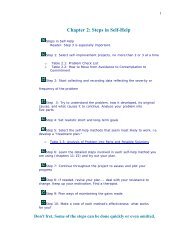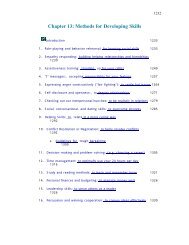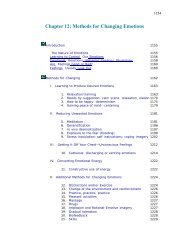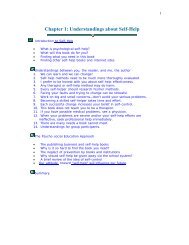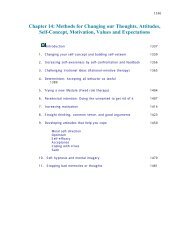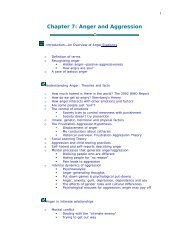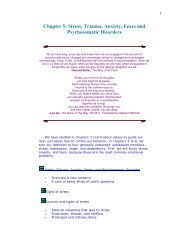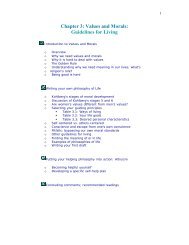Methods for Changing Behaviors - Psychological Self-Help
Methods for Changing Behaviors - Psychological Self-Help
Methods for Changing Behaviors - Psychological Self-Help
Create successful ePaper yourself
Turn your PDF publications into a flip-book with our unique Google optimized e-Paper software.
ein<strong>for</strong>cement: the threat of further punishment was created and that<br />
threat could be escaped by cleaning the room. (Or, the tendency to<br />
procrastinate or rebel was punished and lost strength.) Cleaning his<br />
room is called an "escape response" because the threat of punishment<br />
is turned off. An "avoidance response" is when the teenager cleans his<br />
room even be<strong>for</strong>e being threatened with punishment; his cleaning<br />
avoids punishment and the threat of it, thereby reducing his stress.<br />
Rein<strong>for</strong>cement (+ or -) is the opposite of punishment but the same as<br />
escape from anything unpleasant.<br />
An easy way of telling the difference between punishment and<br />
negative rein<strong>for</strong>cement is to consider the effects. If the target behavior<br />
declines rapidly, it was probably punished; if the target behavior<br />
increases, it was surely rein<strong>for</strong>ced. Fining yourself <strong>for</strong> eating more<br />
than 1200 calories per day is punishment; threatening to fine yourself<br />
<strong>for</strong> not studying two hours per day is negative rein<strong>for</strong>cement if it<br />
results in studying two hours a day or more. Often, punishment<br />
produces immediate changes (escape) whereas negative rein<strong>for</strong>cement<br />
(avoidance) takes time (Miller, 1980).<br />
Finally, don't be confused by negative rein<strong>for</strong>cement being involved<br />
in producing both desired and unwanted behaviors. We learn to avoid<br />
punishment by being good (the clean room miracle mentioned above)<br />
and we often acquire unwanted behaviors (fears, a hot temper,<br />
submissiveness, shyness, and bad habits, like drinking) because they<br />
help us escape unpleasant situations.<br />
There are only a few self-help methods based on negative<br />
rein<strong>for</strong>cement or avoidance and escape. It is vitally important that you<br />
understand negative rein<strong>for</strong>cement so you can understand yourself.<br />
This learning principle is referred to many times in previous chapters,<br />
especially in chapter 4.<br />
Purposes<br />
Steps<br />
· To appropriately avoid, escape or handle an unpleasant<br />
situation, person, thought, feeling, possible punishment or<br />
unwanted consequence. (And to recognize your harmful ways<br />
of avoiding and escaping so you can develop better ways.)<br />
· To use the escape or avoidance of something unpleasant (either<br />
naturally existing or intentionally created) as a rein<strong>for</strong>cer of a<br />
desired behavior.<br />
STEP ONE: Identify the unpleasant experience you want to turn<br />
off and/or the desired behavior you want to strengthen.<br />
The unpleasantness may come from any source: the physical<br />
environment (heat, cold, pain, hunger needs), interpersonal<br />
relationships (anger, excessive demands, boredom), or internal<br />
1137



